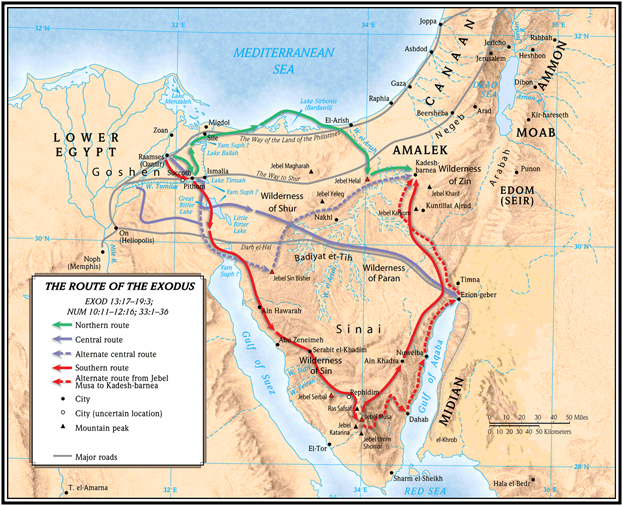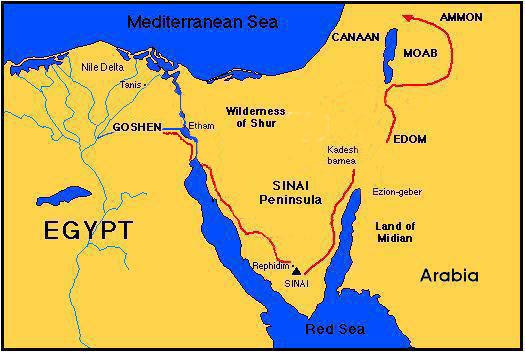The History Channel and similar secular resources often attack biblical history out of hand. The location of Mount Sinai and the giving of the Torah are no exceptions. Much of what these sources present on the Bible are deliberate distortions intended to destroy people's faith in HaShem and promote universalism.
The Torah is accurate no matter what its critics claim. This has been objectively proven many many times. The Written Torah must be understood correctly however. Some is meant to be taken literally, some is clearly symbolic (Jacob's ladder for instance), much is both.
Many solid rabbis reject the view that the Torah was ever intended to be taken as a history book, noting that its teachings transcend literal truth in many cases. What is to be taken literally, the creation account, the world flood, and so on, and what is not is often a personal judgement. In any case, every letter of Torah is true and inspired by HaShem. We must struggle to understand it teachings and apply its wisdom.
As I will show, the Torah is clear that the Hebrews left Egypt, crossed the Red Sea at some point and headed south into the Sinai Wilderness to the historically accepted site of Mount Sinai, now known as Jebel Musa (the "Mountain of Moses").
Let's briefly consider the Exodus from Egypt to the Sacred Mount as presented in the Torah:

The precise geographical point of the "Parting of the Red Sea" and the Hebrew crossing is not absolutely certain. Doubtless the location was very close to the generally accepted point. From my readings I think it was a bit farther south than the following (large) map shows. I think they most likely crossed right about where the word Yam (Suph) is written on that map, in other words, around the point where the widened harbor again narrows into the Gulf of Suez. The terrain has changed considerably after all these years of course:
The solid red line (on this map) denotes their route from Egypt to Mount Sinai as presented in the Torah. According to the Torah Mount Sinai can only be located at Jebel Musa, its traditionally accepted location.
Exodus 12:51 It came to pass on that very day, that the Lord took the children of Israel out of the land of Egypt with their legions.To say the holy Mount was in Egypt (which some do) contradicts the Torah. The Hebrews clearly left Egypt at this time.
To say Sinai was located in Arabia is equally contrary to the Torah as it provides the route taken by Moshe and his followers. This misdirection is often fostered by Muslims hoping to usurp Jewish history and identity and support their claims concerning the centrality of Mecca and Medina.
Exodus 13:17 It came to pass when Pharaoh let the people go, that God did not lead them [by] way of the land of the Philistines for it was near, because God said, Lest the people reconsider when they see war and return to Egypt.So we know they did not go straight into Eretz Israel -- following the "major road" gray line in the map -- (which the Greek sea faring Philistines were currently controlling: the name Philistine of course has nothing to do with the so-called Palestinians who are Arabs). This is why, after the crossing, the Hebrews went south skirting the Wilderness of Sinai as this map accurately shows.
Exodus 13:18 So God led the people around [by] way of the desert [to] the Red Sea, and the children of Israel were armed when they went up out of Egypt.
This is the Wilderness of the Shur/Sinai.
Exodus 13:20 They traveled from Succoth, and they encamped in Etham, at the edge of the desert.The location of Etham is shown on this map. This crossing happened somewhere south of this point:
 The Hebrews went further south where the tip of the Red Sea (its arm being known as the Gulf of Suez) blocked them (Exodus 14:11), a bit south of Darb el-Haj (on the big map). The location of "Pihahiroth, before Baalzephon" is uncertain today (hence we can't be sure exactly where they crossed).
The Hebrews went further south where the tip of the Red Sea (its arm being known as the Gulf of Suez) blocked them (Exodus 14:11), a bit south of Darb el-Haj (on the big map). The location of "Pihahiroth, before Baalzephon" is uncertain today (hence we can't be sure exactly where they crossed).
Exodus 14:16 And you raise your staff and stretch out your hand over the sea and split it, and the children of Israel shall come in the midst of the sea on dry land.
Exodus 14:28 And the waters returned and covered the chariots and the horsemen, the entire force of Pharaoh coming after them into the sea; not even one of them survived.
14:29 But the children of Israel went on dry land in the midst of the sea, and the water was to them like a wall from their right and from their left.
14:30 On that day the Lord saved Israel from the hand[s] of the Egyptians, and Israel saw the Egyptians dying on the seashore.
Exodus 15:22 Moses led Israel away from the Red Sea, and they went out into the desert of Shur; they walked for three days in the desert but did not find water.This would be roughly the area where the Wilderness of Shur blends into the wilderness of Sinai. They headed south along the Gulf of Suez/Red Sea.
Exodus 15:23 They came to Marah, but they could not drink water from Marah because it was bitter; therefore, it was named Marah.Marah today is known as Ain Hawara (see big map). They crossed the Red Sea (Gulf of Suez) somewhere north of Marah (Ain Hawara) and south of Etham (on the small map) and then journeyed south as the red line shows. This is where HaShem made the bitter waters sweet (Exodus 15:25).
Exodus 15:27 They came to Elim, and there were twelve water fountains and seventy palms, and they encamped there by the water.Elim is generally thought to be Wadi Gharandel, probably near Abu Zeneimeh on the big map.
Exodus 16:1 They journeyed from Elim, and the entire community of the children of Israel came to the desert of Sin, which is between Elim and Sinai, on the fifteenth day of the second month after their departure from the land of Egypt.See the large map for the Wilderness of Sin (named after the god Hubal-Sin -- who was also worshiped by the Northern Arabs and later came to be known as the Allah of Muhammad) and note that they are clearly heading toward Jebel Musa (the traditional local of Mount Sinai).
Exodus 16:29 See that the Lord has given you the Sabbath. Therefore, on the sixth day, He gives you bread for two days. Let each man remain in his place; let no man leave his place on the seventh dayShabbat is again confirmed as the eternal Holy Day.
16:30 So the people rested on the seventh day.
Exodus 17:1 The entire community of the children of Israel journeyed from the desert of Sin to their travels by the mandate of the Lord. They encamped in Rephidim, and there was no water for the people to drink.Again, we know where Rephidim is. See the big map. They were now approaching Jebel Musa.
Here, near Horeb, Moshe smote the rock and produced the water for the people to drink (Exodus 17:6).
Exodus 17:8 Amalek came and fought with Israel in Rephidim.Again, this place is well known.
Jethro visits Moshe, then leaves (chapter 18).
Exodus 19:1In the third month of the children of Israel's departure from Egypt, on this day they arrived in the desert of Sinai.So, they left Raphidim and came to the Holy Mount. Continuing in the same basic direction they had been traveling since the parting of the Sea. This would take them directly to Jebel Musa where they dwelt for some time receiving the Torah and so on.
19:2 They journeyed from Rephidim, and they arrived in the desert of Sinai, and they encamped in the desert, and Israel encamped there opposite the mountain.
Then eventually:
Exodus 33:1 The Lord spoke to Moses: "Go, ascend from here, you and the people you have brought up from the land of Egypt, to the land that I swore to Abraham, Isaac, and Jacob, saying: 'I will give it to your descendants.'After the giving of the Torah HaShem sent His people up into Eretz Israel to take possession of our eternal heritage. In this HaShem fulfilled an important part of His promise to Avraham:
33:2 I will send an angel before you, and I will drive out the Canaanites, the Amorites, the Hittites, the Perizzites, the Hivvites, and the Jebusites
33:3 to a land flowing with milk and honey; because I will not go up in your midst since you are a stiff necked people, lest I destroy you on the way.
Genesis 12:1 And the Lord said to Abram, "Go forth from your land and from your birthplace and from your father's house, to the land that I will show you.As the Covenant people of HaShem the Israelites were commanded to reject the religions and gods they encountered on their way to Holy Land (including Allah/Hubal-Sin).
12:2 And I will make you into a great nation, and I will bless you, and I will aggrandize your name, and [you shall] be a blessing.
12:3 And I will bless those who bless you, and the one who curses you I will curse, and all the families of the earth shall be blessed in you."
Deuteronomy 1:6 The LORD our God spake unto us in Horeb, saying, Ye have dwelt long enough in this mount:And therefore after Sinai they changed directions and headed up toward Eretz Israel.
1:7 Turn you, and take your journey, and go to the mount of the Amorites, and unto all the places nigh thereunto, in the plain, in the hills, and in the vale, and in the south, and by the sea side, to the land of the Canaanites, and unto Lebanon, unto the great river, the river Euphrates.
1:8 Behold, I have set the land before you: go in and possess the land which the LORD sware unto your fathers, Abraham, Isaac, and Jacob, to give unto them and to their seed after them.
1:9 And I spake unto you at that time, saying, I am not able to bear you myself alone:
1:10 The LORD your God hath multiplied you, and, behold, ye are this day as the stars of heaven for multitude.
Numbers 11:35 And the people journeyed from Kibrothhattaavah unto Hazeroth; and abode at Hazeroth.Hazeroth was north of Mount Sinai and is believed to be the place now known as Ain el-Hudhera.
Numbers 12:16 And afterward the people removed from Hazeroth, and pitched in the wilderness of ParanAs the large map shows, the Wilderness of Paran is well to the north of Jebel Musa. From Mount Sinai the Hebrews clearly headed north-east skirting the Sinai desert as they approached the land of Canaan.
Numbers 13:17 And Moses sent them to spy out the land of Canaan, and said unto them, Get you up this way southward, and go up into the mountain:It is vital to understand that the Torah's description is clear, rational, and should be accepted as factual. What HaShem did on Mount Sinai was the most important event in human history. He established His Covenant with Moshe for the good of the whole world. The Sinai Covenant established the Eternal Law and Homeland of the Jewish people. These were real events that occurred within history. Upon the Sinai Covenant the Jewish people stand.

